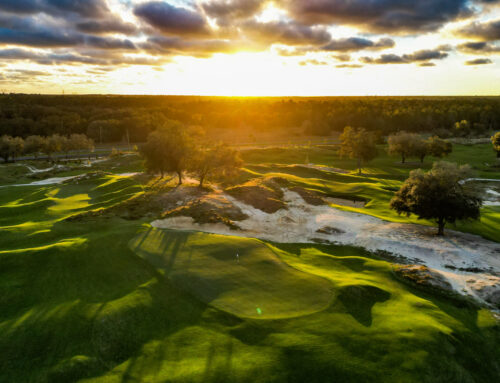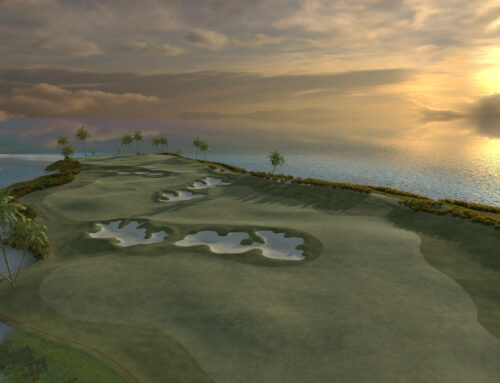Playing Golf at Kawana Hotel GC,
Japan
by
Noel Freeman
The year 2001 was the year I devoted myself to playing as many of the world’s great courses as my schedule allowed. I went on pilgrimages to Scotland, Ireland, England and to Oregon and Nebraska here at home. Then the granddaddy of them all came when I told by my company to shuffle off to Tokyo to work for a week. When I told people I was going to Japan to work for a week they inevitably asked what I would do for fun over there. Immediately, I said, ‘Golf!’
Most people thought this incredulous as golf is widely known to be prohibitively expensive there. That did not matter to me as the most important part was seeing the best course I could while staying in Japan. The architect responsible for Japan’s best two courses were H.S. Colt’s partner Charles Alison. Having played at Swinley Forest and Sunningdale New (both Colt gems) two months prior to my Japan trip my expectations were heightened.
The two best courses in Japan are Hirono (in Kobe) and Kawana, which is located approximately 2 hours south of Tokyo’s center. Kobe is a 4 hour train ride by bullet train from Tokyo and is not a public course. Conversely, Kawana is known as the Pebble Beach of Japan and is open for play to the public. So I decided to play here and then took the arduous task of trying to book a tee time and hotel stay as it is mandatory. Despite repeated attempts and speaking english as slow as possible I was unable to obtain neither a room nor a time to play golf. Raising the white flag, I called my friend George Reilly (A Japanese American) who lived in Tokyo and he handled the arrangements. He decided to join me which was a boon and a curse because the only day we could play together was the day after I landed.

One of Alison’s fairway bunkers. This on is on #14.
The quest to play Alison’s course began with a 4-hour plane delay, a 14-hour flight, followed by three trains and a cab ride that encapsulated another 3 hours. After a quick 6 hours of sleep I awoke to finally play golf in Japan and see what C.H. Alison had brought to the land of the rising sun.
Golf in Japan is an experience unto itself. I learned that first hand. I was told we would have caddies and I felt sorry for them as the day was a typical Japanese summer one i.e. 90 degrees with 100% humidity and overcast. Imagine my shock when two ladies wearing scarves, full long sleeves, long pants and giant helmets introduced themselves to George and me as our loopers. Besides the giant helmets, which resemble a Darth Vader mask on steroids, I could not believe these women could carry clubs and they did not. They had motorized golf carts they would push along the course. The second thing I noticed was I was unable to play from the tips, which were only 6600 yards. Instead I would have to play from shorter tees that measured only 6100 yards and this would affect some of the strategic options Alison had built.
The property Kawana is built on is similar to Pebble Beach in one way, it is dramatic but the cliffs are higher and rockier and the surrounding land looks more like a jungle than the Del Monte Forest. As I approached the first tee at Kawana, I was immediately struck by the imposing fairway bunker lying 180 yards below me. It looked like the bunkering style I had seen at Colt’s gems out in the heathlands. Charles Alison had brought his ‘A’ game to Japan. The first tee at Kawana is elevated and the first hole plays downhill, slightly doglegging to the right and uphill to the Pacific Ocean. It is one of the best starting holes I have played. Still, two things troubled me; it was obvious Alison put this fairway bunker right in the middle of the fairway for a reason. Yet, it was only a scant 180 yards in front of me. From the tips, the bunker would have been in play but I was not allowed to venture back to these tees. The second problem with the opening hole was as I gazed down the fairway two greens were visible. The main green doglegged to the right while a tiny ‘sub’ green stared back at me directly in line with the tee box. Japan has a two green system at most clubs as the ‘sub’ greens handle play during the muggy, hot summers. These greens were generally devoid of contour and approximately 40-50% the size of the normal greens. Basically, they are like playing temporary greens in the winter here in the United States.
The other unique trait about Japanese golf is the playing surfaces and greens. The turf is Korai grass. Korai grass is both a boon and a curse. It is Bermuda grass on steroids. When you are in the fairway, Korai grass is fantastic as the ball sits up almost as if it is on a tee. Divots are tough to take. Where Korai grass is a curse is in the rough and on the greens. Hitting out of the rough invites the possibility of a broken wrist while trying to hack out of it and putting on the greens is another challenge in itself. When you putt on Korai, the ball skids rather than rolls to the hole. If you hit a patch of irregular growing grass, the ball can skid way off line despite having the right line.
Having debated the differences in Japanese golf before my tee shot, I finally struck a 240 yard downhill 3-wood on the 409yd first hole. With a great lie, I hit a 6-iron to the uphill green and then three putted on korai for bogey. Not a great start but the course was just warming up.
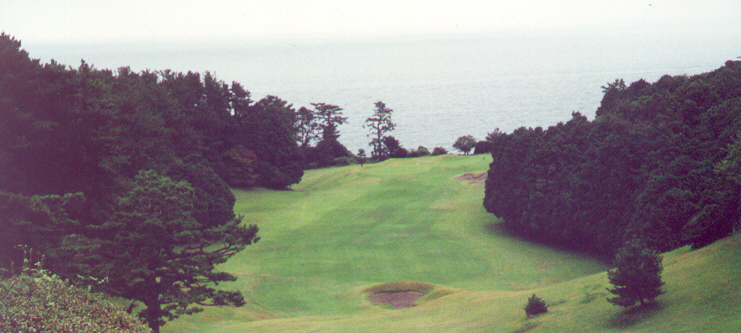
The tee shot on the 1st hole at Kawana is a drop shot with the fairway bunker lying 180 yards from the tee. The approach shot doglegs slightly right and is uphill to the Pacific Ocean.
The 2nd hole at Kawana plays parallel to the ocean. A nasty looking fairway bunker lies in wait 210 yards out in the fairway for the intermediate player and an even deeper pit lies left of the green for a pulled approach.
The 3rd hole at Kawana looks funny on the card, a 420 yard par 5? Well this par 5 plays about 490 yards and doglegs mightily right up a big hill. Alison confounds the golfer by placing 3 cavernous bunkers at 180/210/240 yards. The more you try and cut the hole into a par 4 and get there in two, the more Alison demanded of your tee shot. On the right side of the hole, trees were planted as well so that any ball trying to cut off the dogleg would be penalized with either bunkering or a hack out of the woods.
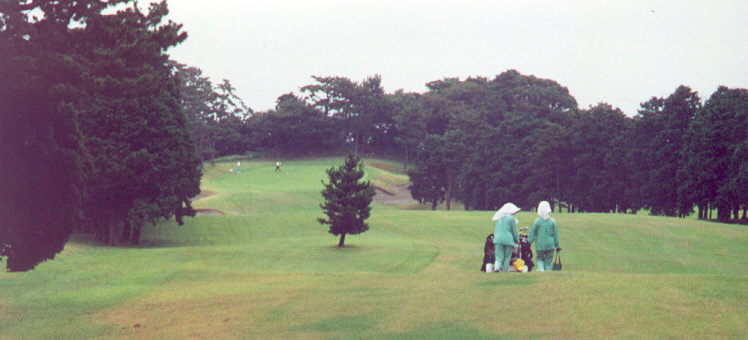
Approach to the uphill short par 5 #3. This hole doglegs to the right and requires a carry over a fairway bunker 240yds out to have a chance at reaching in two. Our Japanese lady caddies frame the picture.
The 4th hole at Kawana is another 3 shotter that plays much shorter than the 480 yards on the scorecard. The hole plays steeply downhill if you can hit your tee shot 280 yds and catch a big downslope it leaves you a wedge and a good shot at eagle. The hole is surrounded by nasty bunkering which makes up and down a challenge.
The first par 3 at Kawana is 150 yards and a drop shot at that. I would estimate the elevation change at 40 feet. The wind can blow right off the Pacific and is the key defense to the hole. It took me a 6 iron into the wind to get home despite the fact I think it played only 135 yards.
The 7th hole is where Alison’s genius takes form. Only 330 yards long, it looks like you can drive the green as it plays slightly downhill but do not be fooled. Before you take out your driver you see several fairway bunkers staring you in the face and there is OB right and left. The green slopes off sharply from the right for any pushed approach. I thought birdie on the tee but realized a 6 is easily possible here.
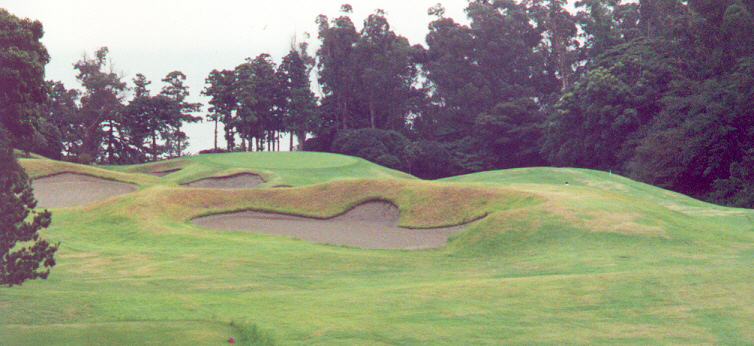
The tee shot on the 7th hole with fairway bunkering outlining a narrow landing area and a big drop off right of the green. An accurate drive leaves you with an easy pitch but any aggressive play off the tee will land you in the bunkering or leave a dicey pitch right of the green.
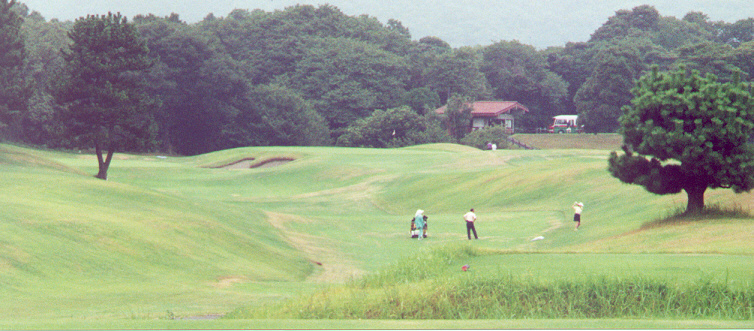
The gullied/sunken fairway on the 9th hole where Alison challenges you to be accurate with your driver.
When you finish the front 9 at Kawana you experience another of Japan’s idiosynchrisies. You must break for a sushi lunch. After shooting a jet lagged 40, I did not want to do this but after enjoying a great meal in the hotel it did not matter. I did not realize my full belly would make play sluggish on the back.
The back 9 at Kawana opens with the 135 yard par 3 10th. An elevated green with good bunkering surrounds it. A good hole but nothing special.
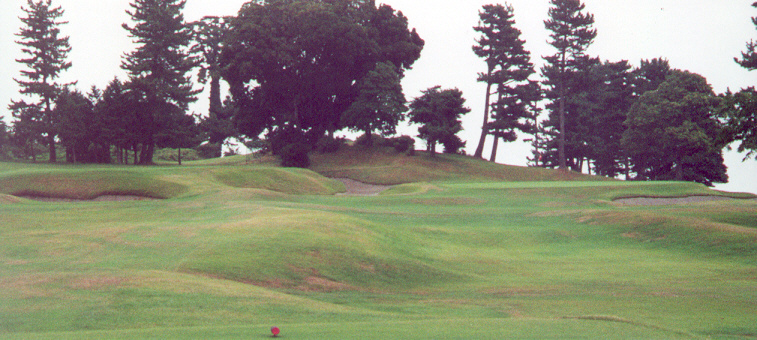
Dual green sites on the par 3 10th. The original green is to the left while the ‘sub’ temporary green is on the right.
The 11th hole plays 619 yards from the tips and gives you an expansive view of the next few holes, a Japanese landscape at that but like some of the views one would see on a heathland course. The most interesting aspect to the 11th hole which played over bland ground as it spilled near the greenside lighthouse was the green contour itself. This was a big 2 tier green that was ruined by korai grass. My ball was grasped so hard by the korai grass that it got stuck between tiers. Something I have never seen for a ball that was not embedded.
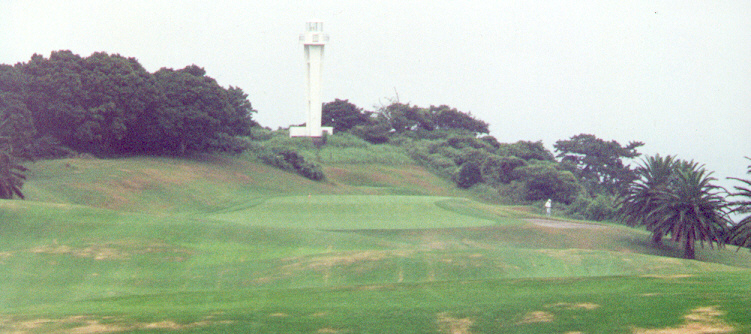
The 619 yard 11th hole which plays over wide open terrain down to the lighthouse. The landscape is full of great vistas here as the back 9 plays more ‘heathland-like’ in its vistas. The green is also two tiered with one caveat: The korai grass can leave your ball stuck between tiers!
The 416 yard 14th is a semi-blind tee shot with another well placed fairway bunker at the 225 yard length coaxing you to go right off the tee. The only problem is a lone tree guards the right side and play havoc with any misplaced shot.
The 470 yard par 5 15th is the signature hole at Kawana. The ocean is just a jump off the cliff to your left and in order to shorten the hole you have to bite off a fair bit of jungle to do it. The hole has a cape like quality. If you don’t dare the 230 yard carry and pick the safer route to the right, Alison places more of his fairway bunkers there to reward you for playing safe. As you approach the green, you notice it is sunken down and the green is split with a ridge running down the right side effectively making it two-tiered. It was my favorite green on the course.
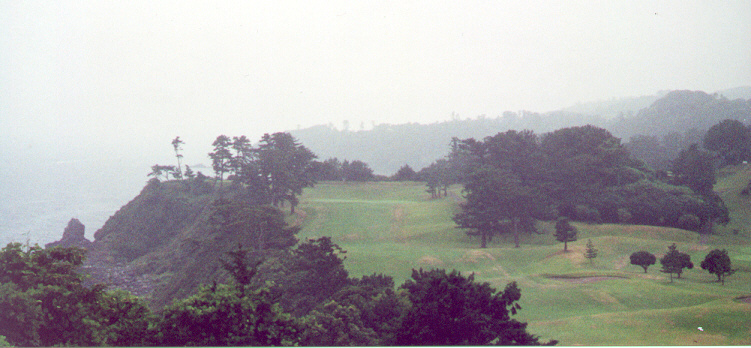
The famous 15th hole at Kawana.
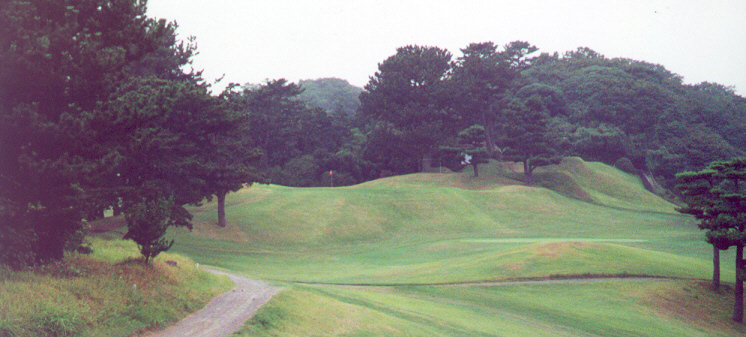
The crowned/elevated par 3 16th with a drop-off to the left. A very tough green to hit and any pulled tee shot is a challenge to get up and down.
The 17th at Kawana plays 410 yards from the tips with a huge mound 230 yards out that obscures a deep-pitted bunker. The hole also plays slightly uphill towards the higher ridge at the top of the property. This is the finishing hole when Japanese Tour events are played at Kawana and it is a good one at that.
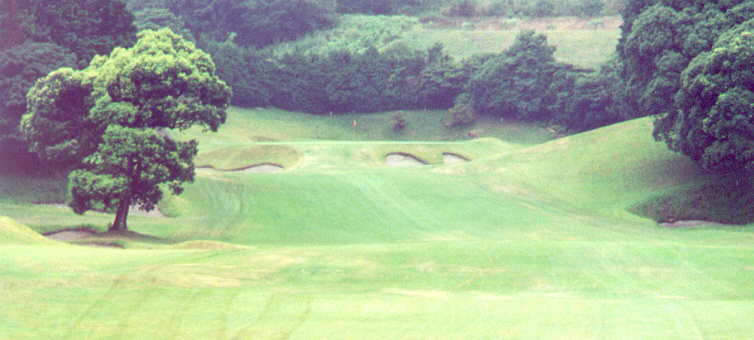
18th hole. Note the movement in the fairway and well protected/elevated green.
When I finished my round at Kawana, I had got what I paid for. Charles Alison took a lot from the heathland gems his partner built in England and imported them to Japan. The course’s main tenet is strategy off the tee and the bunkering was superb. The only caveats I had with the course was the temporary ‘sub’ greens which are an eye sore and the lack of contour as a rule. Perhaps the contour would not matter anyway with the korai grass spoiling many a putt. In the end, Kawana was worthy of the quest.
Now if only I can get to Hirono….
The End


